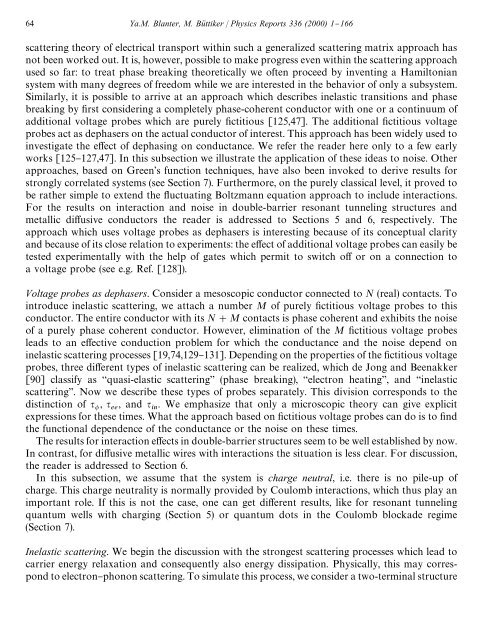shot noise in mesoscopic conductors - Low Temperature Laboratory
shot noise in mesoscopic conductors - Low Temperature Laboratory
shot noise in mesoscopic conductors - Low Temperature Laboratory
You also want an ePaper? Increase the reach of your titles
YUMPU automatically turns print PDFs into web optimized ePapers that Google loves.
64 Ya.M. Blanter, M. Bu( ttiker / Physics Reports 336 (2000) 1}166<br />
scatter<strong>in</strong>g theory of electrical transport with<strong>in</strong> such a generalized scatter<strong>in</strong>g matrix approach has<br />
not been worked out. It is, however, possible to make progress even with<strong>in</strong> the scatter<strong>in</strong>g approach<br />
used so far: to treat phase break<strong>in</strong>g theoretically we often proceed by <strong>in</strong>vent<strong>in</strong>g a Hamiltonian<br />
system with many degrees of freedom while we are <strong>in</strong>terested <strong>in</strong> the behavior of only a subsystem.<br />
Similarly, it is possible to arrive at an approach which describes <strong>in</strong>elastic transitions and phase<br />
break<strong>in</strong>g by "rst consider<strong>in</strong>g a completely phase-coherent conductor with one or a cont<strong>in</strong>uum of<br />
additional voltage probes which are purely "ctitious [125,47]. The additional "ctitious voltage<br />
probes act as dephasers on the actual conductor of <strong>in</strong>terest. This approach has been widely used to<br />
<strong>in</strong>vestigate the e!ect of dephas<strong>in</strong>g on conductance. We refer the reader here only to a few early<br />
works [125}127,47]. In this subsection we illustrate the application of these ideas to <strong>noise</strong>. Other<br />
approaches, based on Green's function techniques, have also been <strong>in</strong>voked to derive results for<br />
strongly correlated systems (see Section 7). Furthermore, on the purely classical level, it proved to<br />
be rather simple to extend the #uctuat<strong>in</strong>g Boltzmann equation approach to <strong>in</strong>clude <strong>in</strong>teractions.<br />
For the results on <strong>in</strong>teraction and <strong>noise</strong> <strong>in</strong> double-barrier resonant tunnel<strong>in</strong>g structures and<br />
metallic di!usive <strong>conductors</strong> the reader is addressed to Sections 5 and 6, respectively. The<br />
approach which uses voltage probes as dephasers is <strong>in</strong>terest<strong>in</strong>g because of its conceptual clarity<br />
and because of its close relation to experiments: the e!ect of additional voltage probes can easily be<br />
tested experimentally with the help of gates which permit to switch o! or on a connection to<br />
a voltage probe (see e.g. Ref. [128]).<br />
Voltage probes as dephasers. Consider a <strong>mesoscopic</strong> conductor connected to N (real) contacts. To<br />
<strong>in</strong>troduce <strong>in</strong>elastic scatter<strong>in</strong>g, we attach a number M of purely "ctitious voltage probes to this<br />
conductor. The entire conductor with its N#M contacts is phase coherent and exhibits the <strong>noise</strong><br />
of a purely phase coherent conductor. However, elim<strong>in</strong>ation of the M "ctitious voltage probes<br />
leads to an e!ective conduction problem for which the conductance and the <strong>noise</strong> depend on<br />
<strong>in</strong>elastic scatter<strong>in</strong>g processes [19,74,129}131]. Depend<strong>in</strong>g on the properties of the "ctitious voltage<br />
probes, three di!erent types of <strong>in</strong>elastic scatter<strong>in</strong>g can be realized, which de Jong and Beenakker<br />
[90] classify as `quasi-elastic scatter<strong>in</strong>ga (phase break<strong>in</strong>g), `electron heat<strong>in</strong>ga, and `<strong>in</strong>elastic<br />
scatter<strong>in</strong>ga. Now we describe these types of probes separately. This division corresponds to the<br />
dist<strong>in</strong>ction of ( , , and . We emphasize that only a microscopic theory can give explicit<br />
expressions for these times. What the approach based on "ctitious voltage probes can do is to "nd<br />
the functional dependence of the conductance or the <strong>noise</strong> on these times.<br />
The results for <strong>in</strong>teraction e!ects <strong>in</strong> double-barrier structures seem to be well established by now.<br />
In contrast, for di!usive metallic wires with <strong>in</strong>teractions the situation is less clear. For discussion,<br />
the reader is addressed to Section 6.<br />
In this subsection, we assume that the system is charge neutral, i.e. there is no pile-up of<br />
charge. This charge neutrality is normally provided by Coulomb <strong>in</strong>teractions, which thus play an<br />
important role. If this is not the case, one can get di!erent results, like for resonant tunnel<strong>in</strong>g<br />
quantum wells with charg<strong>in</strong>g (Section 5) or quantum dots <strong>in</strong> the Coulomb blockade regime<br />
(Section 7).<br />
Inelastic scatter<strong>in</strong>g. We beg<strong>in</strong> the discussion with the strongest scatter<strong>in</strong>g processes which lead to<br />
carrier energy relaxation and consequently also energy dissipation. Physically, this may correspond<br />
to electron}phonon scatter<strong>in</strong>g. To simulate this process, we consider a two-term<strong>in</strong>al structure
















